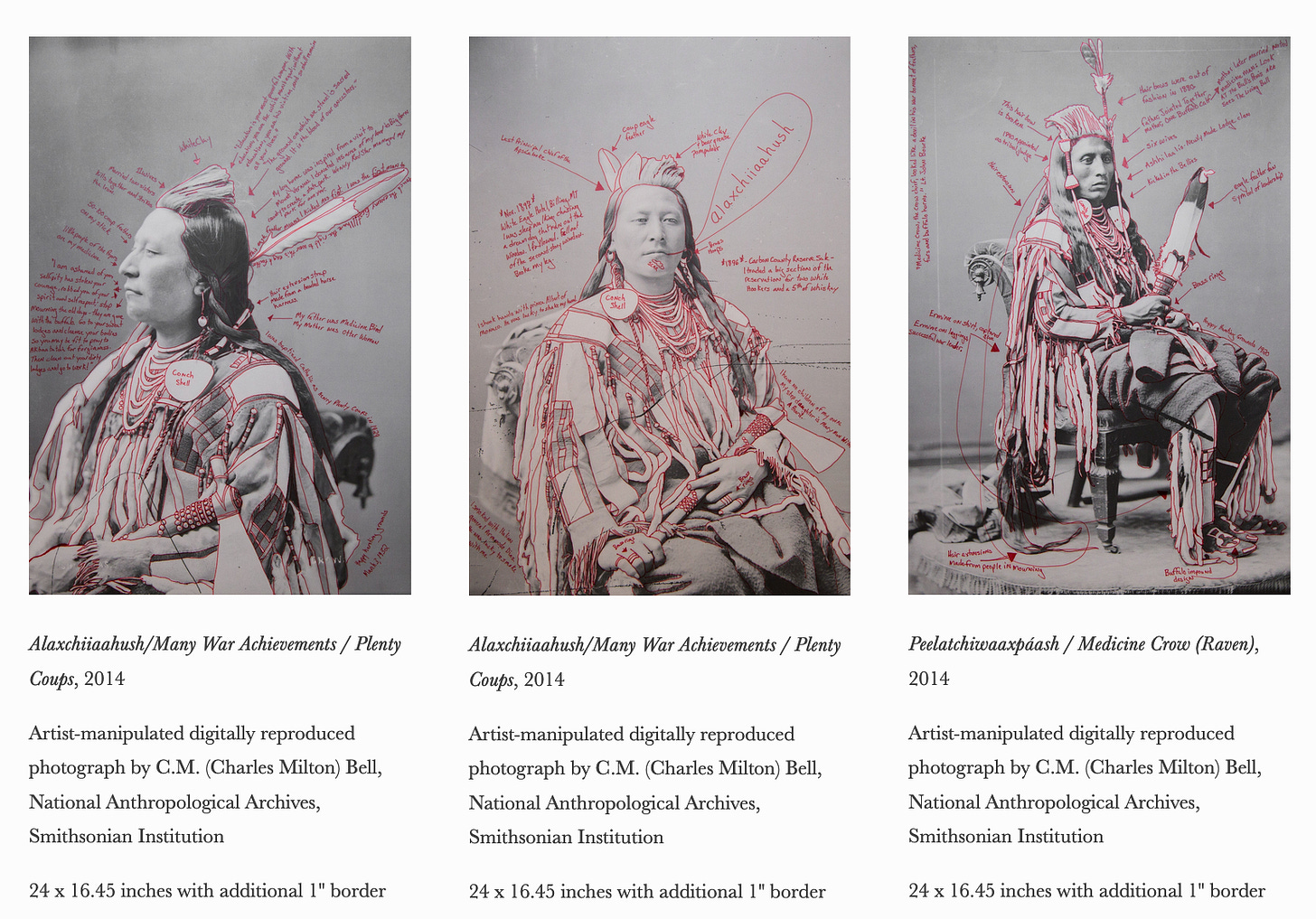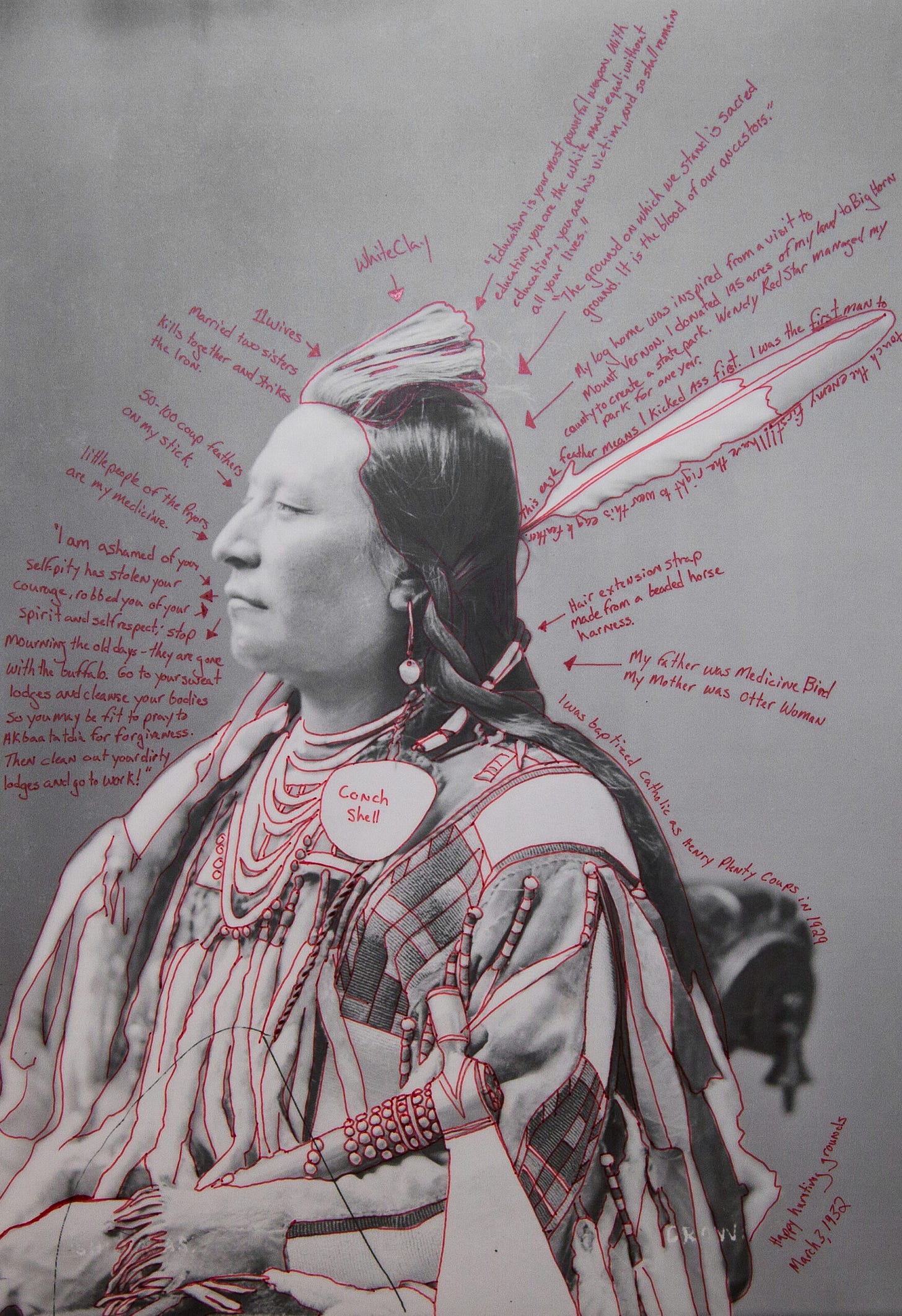Focal Points
Adding to the "photo mapping" idea. Plus The Heard.
The excellent comments on last week’s “Map the Picture” post included a great tip from reader Ckarp, who asked if I was familiar with the work of artist Wendy Red Star.
I was not. But I am now and want to share a bit of that work with you. Among other things, it adds some interesting possibilities to the photo “mapping” idea.
Red Star is an Apsáalooke multimedia artist born in Billings, Montana, now based in Portland, Oregon. She’s created an impressive array of work, but the series I want to highlight is a 2014 set of ten images she titled “1880 Crow Peace Delegation.”
Wendy Red Star
The series consists of photographs originally taken by a Washington, D.C., studio photographer of a delegation of Crow chiefs and leaders that Red Star has digitally manipulated and annotated — and in the process, recontextualized. To quote from the site of the Birmingham Museum of Art:
Red Star, who is herself Crow, observed that the portraits, as with many historic photographs of Native American people, had made their way into the public domain with no identifying information about the sitters, and were appropriated for use in commercial advertisements. She discovered a photograph of one member of the delegation—Chief Medicine Crow—used in an advertisement for Honest Tea. This appropriation has taken place for over a century, with Native American faces and bodies used to sell everything from tobacco to cologne.
In Red Star’s series, she has annotated the scanned photographs, identifying the names of the sitters and details about their lives. She researched each individual and provides commentary on their status, accomplishments, relationships, and particularly the symbolic significance of their regalia. … Some of Red Star’s annotations are imagined, and reflect her own humor, such as “I can kick your ass with these eyes,” or “I am not a fan of the white man.”
Wendy Red Star, “Alaxchiiaahush / Many War Achievements / Plenty Coups” from the series 1880 Crow Peace Delegation, via Birmingham Museum of Art website.
This approach clearly has parallels to the “mapping” project of studying and deconstructing images through careful observation, and speculation.
But the focus on detailed research adds another element. And so too does the distinct point of view.
Red Star’s own site quotes an essay by Nadiah Rivera Fellah and Tricia Laughlin Bloom from the catalog for a Newark Museum show, Wendy Red Star: A Scratch on the Earth. It reads:
The written text includes personal observations and historical facts about the Crow Delegations, a process that inspired personal revelations filtered through the artist’s own experiences as a Crow woman. As Red Star explains, “When I was growing up, there was such pressure to prove one’s [Crow] ancestry that previous generations did not have. I was surprised to see that in these portraits, the tribal leaders from generations ago are wearing things from other tribes, like the Lakota or Cheyenne moccasins that Old Crow wears. I came to realize that the history of identity goes beyond surface value – there’s a complexity to it.” …
… Each print requires careful looking and encourages intimate proximity to the portrait, as Red Star draws attention to the materiality of the sitters’ regalia, bringing each figure to life for viewers. Like the handwritten notes in some of Red Star’s other series, language is central to the artist’s exploration of the critical issues in the Peace Delegation series. …
As that last bit notes, Red Star has used annotations in other works. This example is just (to me) particularly vivid. And in thinking about using annotation or “mapping”’ as a tool for deeper observation, it offers some extra ideas — different focal points.
When examining an image, is there research to be done? Is there an argument to be made about what’s being shown (or not shown)? Does that argument complement or contradict what the image seemed to be saying at first glance?
My thanks again to Ckarp.
THE HEARD
Telling you about one randomly overheard song that I’ve enjoyed lately: Little unexpected bursts of delightful music are definitely things I savor.
E and I heard this country cover of the REO Speedwagon megahit on WEVL’s Rock House. I should acknowledge that I liked it much more than E did ;)
OKAY THAT’S IT! HAVE A GREAT WEEK!
As always, I value your feedback (suggestions, critiques, positive reinforcement, constructive insults, etc.), as well as your tips or stories or personal noticing rituals, things we need a word for, and of course your icebreakers: consumed@robwalker.net. Or use the comments.
And thanks for reading …
rw
Twitter | RobWalker.net | NB: I use (some) Amazon Affiliate links
All this by Rob Walker PO Box 171, 748 Mehle St., Arabi LA 70032
—> If you enjoy this newsletter, please help spread the word! Or just click the heart button, that’s always very appreciated!
If someone forwarded you this subscriber-only edition, and you enjoyed it, consider signing on yourself.



Thank you and Ckarp for sharing the work of Wendy Red Star. This is absolutely fascinating and would not have heard about her or her art (despite living in Portland) if not for this post.
Thanks for this. I've gone down the rabbit hole looking at Wendy Red Star's work and subsequently discovering other remarkable contemporary indigenous artists.